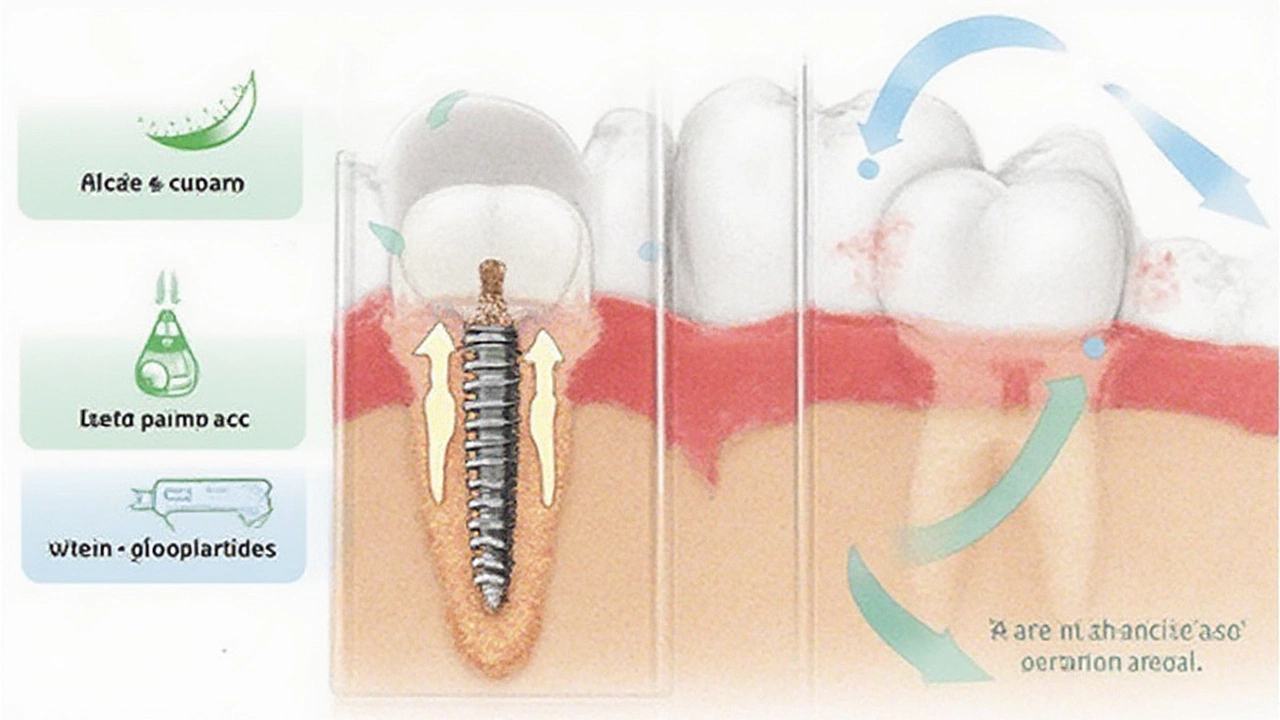You’ve happily splurged on dental implants, expecting that picture-perfect, low-maintenance smile. The last thing you want is yesterday’s dal chawal spoiling the vibe—literally getting stuck where it doesn’t belong. Maybe you’ve heard horror stories: friends muttering about “stuff stuck under implants” as if their dinner is haunting them for days. But is food actually worming its way under those pricey dental investments? Or is there more to the story? Let’s get past the whispers and find out what really happens with food and dental implants—so you can eat, laugh, and talk without worry.
Can Food Really Get Under Dental Implants?
It’s a common fear: you take a bite of a kebab or a sandwich and suddenly find yourself fishing with your tongue, convinced something has slipped under your dental implant. Actually, a well-placed dental implant is designed to sit tightly against the gum—leaving barely any gaps for food to creep through. The crown (the visible tooth-like part) sits on a titanium post, which is fused with your jawbone. If the procedure is done right, food sliding under the implant shouldn’t happen. But reality likes to throw curveballs sometimes.
Here’s where it gets tricky. While the implant itself is closed off at the base, the edges where the crown meets the gum can sometimes develop tiny spaces. This usually happens if gums have receded after the implant is placed, or if healing didn’t go as planned. According to a 2023 study from the Indian Dental Association, about 12% of implant recipients notice food debris at the gumline after eating, but only 2% actually experience food getting fully lodged under the crown itself—almost always due to gum shrinkage or gaps at the gum-crown interface. By comparison, natural teeth actually trap food more often between them than properly fitted implants!
But what does it feel like? People describe everything from a tickle to annoying pressure after eating sticky or fibrous foods like spinach, caramel, or grilled meat. If a gap exists, even something as simple as rice can find its way in. The sensation isn’t just uncomfortable; trapped food can irritate your gums or even lead to infection if left for long. Fresh implants are especially sensitive—gum tissues are still healing, making them more vulnerable for the first 4-6 weeks.
So, short answer: food isn’t meant to get under dental implants, but it happens in certain situations—especially if there’s been gum recession, initial healing issues, or shoddy dental work. Good news: a skilled dentist can usually adjust the fit so these gaps are sealed properly.
| Cause | Likelihood | What to Do |
|---|---|---|
| Perfectly placed implant & crown | Rare | Normal brushing and flossing |
| Mild gum recession after healing | Sometimes | Re-contour crown, pay attention to hygiene |
| Poor fit of crown | Possible | See your dentist for corrections |
| Improper healing, gum shrinkage | Occasional | Pocket cleaning, adjust crown shape |
The bottom line? If you feel something wedged near your implant, don’t panic. But don’t ignore it either—persistent debris could mean it’s time for a dental check-up to fix any underlying gap or gum issue that’s inviting trouble in.

Why Does Food Sometimes Get Stuck Under Implants?
If you’ve just invested lakhs into a new set of teeth, it’s pretty annoying to worry about chapati or chicken fibers setting up shop under your crown. But several things can cause these annoying incidents:
- Gum Recession: This is the sneaky culprit behind most complaints. When the gum tissue around an implant pulls away (due to natural healing, brushing too hard, or poor oral hygiene), a tiny space forms around the crown. Even half a millimeter is enough for bits of food to slip through.
- Poor Crown Shape or Position: If the dental technician makes the crown too small or the wrong shape, the edges won’t hug your gums tightly. Sometimes, crowns are fitted a bit above the gum line to avoid pressing too hard on the healing area. Over time, this can leave micro-gaps.
- Bone Loss Over Time: Especially true if you lost your natural tooth to gum disease, your jawbone might shrink a bit even after implant surgery. The gum line follows the bone—so any shrinkage leaves extra room under the crown.
- Improper Healing After Surgery: If the gum doesn’t fully close around the post, it may leave gaps or an uneven cuff where food can sneak in.
- Smoking and Health Conditions: People who smoke, have diabetes, or struggle with chronic gum problems are more likely to notice food traps, since their healing is slower and gum tissues stay inflamed.
Let's put it another way: picture installing a tap in your sink. If the plumber gets the seal wrong, trickles of water escape no matter how tight you twist. Similarly, with dental implants, it’s all about precision—the gum, the bone, the way the crown hugs it all. Just the tiniest misfit, and food particles get adventurous.
There’s another, less obvious factor—your chewing style. People who favour one side of the mouth, rush their meals, or skip regular flossing give food debris a free pass to sneak where it shouldn't. Did you know that in a small 2024 survey by a Mumbai-based prosthodontic team, people with quick, forceful chewing movements had almost 30% more complaints of food debris at the gumline compared to slow chewers? These patterns don't just change how you eat—they shape where food likes to hide.
Also, people with multiple implants or full dentures fixed on implants experience more “gap challenges” than those with single crowns. With each new tooth added, there’s a higher chance that minor misalignments pop up—the mouth is dynamic, always changing shape as you age, lose bone, or gain weight.
And here's one thing most people don't expect: even if you can't see a gap, microscopic spaces at the gum-crown interface can still harbor bacteria and food particles. That's why some implant patients get persistent bad breath (halitosis) even if their brushing game is strong.
The good news? Once you understand what's going on, you can do plenty to prevent these annoyances—or fix them if they show up.

Best Practices: Keeping Food Out and Your Implants Healthy
Let’s get practical. Nobody’s got time for fussy routines, but some tweaks to your daily care—plus a few timely checkups—make all the difference between a happy implant (and a fresh smile), and dealing with chronic food traps.
- Use the Right Toothbrush: Soft-bristled brushes do less damage to the gums and gently sweep debris away from the gumline. Electric toothbrushes with small heads work great around implants, reaching tough angles without pushing too hard.
- Floss, But with a Twist: Dental floss is the old standard, but for implants, try “super floss” or floss threaders—they have a thicker, spongy bit that grabs stubborn food bits. Water flossers (like Waterpik) are even better; they blast water around the implant and under the crown, flushing out surprises.
- Mind Your Technique: Hold floss just below where gum and crown meet, and gently curve it to hug the implant. Avoid sawing back and forth, which can hurt healing gums.
- Rinse With Antibacterial Mouthwash: Look for mouthwashes with chlorhexidine or cetylpyridinium chloride—these cut down plaque, bacteria, and food debris.
- Eat Smart, Especially Early On: For the first two months after getting an implant, stick to softer foods—think curd rice, bananas, cooked veggies—that leave less debris. Chewy, fibrous, or sticky foods can wedge in new gaps before the gum fully tightens around your new crown.
- Book Regular Dental Check-Ups: Even if your implant feels fine, a quick check every 6 months helps catch early gum shrinkage, bone loss, or crown misfit. The dentist can use an explorer tool to check for sneaky gaps invisible to the eye.
- No Smoking: Quit or at least cut back. Smoking is infamous for slowing down gum healing, increasing recession, and hiking the risk of implant failure.
- Hydrate Well: Drinking water between meals helps wash away loose debris and diluted acids. In Pune’s dry summers, a dry mouth can make food stick more easily.
- Watch for Warning Signs: If you notice tenderness, gums pulling away, persistent bad breath, or see a visible gap, don’t wait. Early repair is much simpler than full crown replacement down the line.
Here’s a quick breakdown of what really keeps implants healthy (and food-free):
| Daily Task | Why It Works |
|---|---|
| Brushing twice (soft brush) | Removes plaque/debris without irritating gums |
| Water flosser | Flushes food from under gum/crown margin |
| Mouthwash (antibacterial) | Keeps bacteria and plaque at bay |
| Dental visits (every 6 months) | Catches early signs of gap or food trap |
Busted crown or persistent food troubles? Sometimes the answer is a simple crown adjustment or a gum “tuck”—a small, fast procedure where the dentist repositions your gum so it hugs the crown tightly again. Or, if bone loss is sneaking up, bone grafts can restore lost structure and close spaces. About 7% of implant patients will need a minor “touch up” like this in the first five years—don’t feel unlucky if you’re one of them.
Small changes add up fast. Chewing on both sides of the mouth, keeping a bottle of water handy during meals, and not ignoring minor irritation will keep your dental implants trouble-free. And don’t forget: see your dentist before little food traps become big (and costly) headaches. That way, you spend less time fishing for bits and more time flashing that fresh, confident smile.





